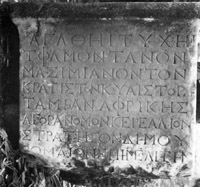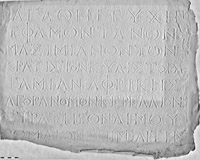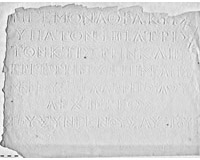 MAMA XI 104 (Akmoneia)
MAMA XI 104 (Akmoneia) 
Honorific base for T. Fl. Montanus Maximianus
- Type of monument:
- Honorific base.
- Location:
- Ahat (Akmoneia): in a lane below the acropolis.
- Description:
- Whitish marble base with small mouldings above and below. Cut in two and bored vertically to make aqueduct pipes.
- Dimensions:
- Ht. 0.60+ (A), (B) 0.60+; W. 0.59 (upper moulding), 0.53-0.55 (shaft), 0.62 (lower moulding); Th. 0.58 (upper moulding), 0.55-0.58 (shaft), 0.63 (lower moulding); letters mostly 0.029-0.035.
- Record:
- Squeeze; line drawing; MB notebook copy; photograph (1955/105-6).
- Publication:
- None.
- Date:
- c. AD 231 (prosopography)
A
ἀγαθῆι τύχηι
Τ. Φλ. Μοντανὸν
Μαξιμιανὸν τὸν
κράτιστον κυαίστορα
5ταμίαν Ἀφρικῆς
ἀγορανόμον κερεάλιον
στρατηγὸν δήμου
Ῥωμαίων ἐπιμελητὴν
[- - - - - - - - - -] Ν̣Ο̣ .
B
ἡγεμόνα Θρᾴκης
ὕπατον ἡ πατρὶς
τὸν κτίστην καὶ εὐ-
εργέτην hed. ἐπιμελησα-
5μένου · Τ · Φλ · Λεντούλου
vac. ἀρχιερέως vac.
τοῦ συνγενοῦς αὐτοῦ.
ἀγαθῆι τύχηι
Τ. Φλ. Μοντανὸν
Μαξιμιανὸν τὸν
κράτιστον κυαίστορα
5ταμίαν Ἀφρικῆς
ἀγορανόμον κερεάλιον
στρατηγὸν δήμου
Ῥωμαίων ἐπιμελητὴν
[- - - - - - - - - -] Ν̣Ο̣ .
B
ἡγεμόνα Θρᾴκης
ὕπατον ἡ πατρὶς
τὸν κτίστην καὶ εὐ-
εργέτην hed. ἐπιμελησα-
5μένου · Τ · Φλ · Λεντούλου
vac. ἀρχιερέως vac.
τοῦ συνγενοῦς αὐτοῦ.
(A) With good fortune. His homeland (honoured) T. Fl. Montanus Maximianus, the most excellent quaestor, quaestor of Africa, aedilis cerealis, praetor of the Roman people, curator...
(B) ...governor of Thrace, consul, founder and benefactor. T. Fl. Lentulus the high-priest, his relative, was responsible (for setting up the base).








This monument is an honorific base for a member of the local Akmoneian elite, T. Flavius Montanus Maximianus, who pursued a successful senatorial career, culminating in the consulship. He is no doubt descended from an earlier T. Flavius Montanus of Akmoneia, high-priest of Asia during the reign of Trajan, attested both at Akmoneia and in several inscriptions from Ephesos (IGR IV 643+1696; I.Ephesos 498, 698, 854, 1130, 2037, 2061-3; Campanile 1994: 96). Although the loss of the central part of the inscription has obliterated several of his praetorian offices, Maximianus’ career seems to have followed a standard pattern:
quaestor (urbanus)
quaestor provinciae Africae
aedilis Cerialis
praetor
curator [- -]
- - -
legatus Augusti pro praetore provinciae Thraciae
consul
In lines 4-5, the terms κυαίστωρ and ταμίας both denote the Latin quaestor. Maximianus has evidently held office as quaestor twice, once in Rome, and once in the province of Africa. The double quaestorship is well-paralleled; it is usually assumed that the second appointment arose in cases when one of the provincial quaestors died during the period between election and the start of the proconsular year (Mommsen, Staatsrecht II 259; Birley 1981: 282).
It seems not previously to have been noted that although in Latin the term quaestor is regularly used for both the urban and provincial quaestorships (e.g. Q. Petronius Melior [ILS 1180; PIR2 P 290], quaest(or), quaest(or) prov(inciae) Narbon(ensis)), in Greek the two posts are consistently distinguished, as in our inscription (the transliteration κυαίστωρ for the urban quaestorship, the Greek translation ταμίας for the provincial quaestorship). Compare: (1) IGR IV 1741 (Kassaba), anonymous, ταμίαν Λυκίας Παμφυλίας, κυαίστορα (Corbier 1974: 454-8; Christol 1986: 315-25); (2) I.Ephesos 3038, Cn. Pompeius Ant. Amoenus, κυαίστορος, ταμίου Λυκίας Παμφυλίας (PIR2 P 590); (3) SEG 6, 555 (Pisidian Antioch), P. Flavonius Paulinus, κυαίστο[ρα], ταμίαν ἐπαρχίας Κύπρου (PIR2 F 448). The sole alleged use of the transliteration κυαίστωρ for a provincial quaestorship occurs in RECAM II 414 (Tavium: Galatia), in the cursus-inscription of M. Antonius Memmius Hiero (PIR2 A 850; Corbier 1974: 328-32). Hiero is here described as κουαίστορα̣ [ἐπαρχείας Λυκί]|ας Παμφυλ[ίας]. Since the use of the term κυαίστωρ for a provincial quaestorship would be unparalleled, we ought presumably to restore a double quaestorship here too: κουαίστορα̣, [ταμίαν Λυκί]|ας Παμφυλ[ίας].
After his second quaestorship, Maximianus held office as aedilis Cerialis. The use of the mixed Graeco-Latin phrase ἀγορανόμον κερεάλιον to represent aedilis Cerialis seems to be unparalleled; in SEG 6, 555 (Pisidian Antioch), the Latin title is simply transliterated, αἰ[δίλιν] κερεάλιν. After his praetorship, Maximianus held an uncertain number of praetorian offices, beginning with a curatorship of some kind (curator viarum, reipublicae, etc.), and concluding with the governorship of Thrace.
Maximianus’ consulship is the latest office to be mentioned in our inscription. However, we have good reason to infer a subsequent proconsulship of Asia. I.Ephesos 698 is an honorific inscription for a proconsul of Asia, dated to the third century AD: Φλ. Μον[τανὸν]| Μαξιμι̣λ̣[λιανὸν]| τὸν λαμπρό[τατον ἀνθ]|ύπατον (lines 1-4). Nollé suggested identifying the proconsul of I.Ephesos 698 with the proconsul [- -] ος Μαξιμ[ι]λλιανό[ς] of TAM V 3, 1422 (Maionia), whose term of office can be firmly dated to AD 253/4 (Nollé 1982: 66-7; endorsed at PIR2 M 390). However, Eck and Roxan have now proposed a more plausible identification for the proconsul of AD 253/4, namely P. Marcius Maximillianus, legatus Augusti of Pannonia superior in AD 240, cos. suff. c. AD 237/8 (AE 1998, 1619; Eck and Roxan 1998: 107). We ought instead to restore the name of the proconsul of I.Ephesos 698 as Φλ. Μον[τανὸν]| Μαξιμι̣α̣[νόν], permitting us to identify him with the consularis T. Flavius Montanus Maximianus of the new inscription from Akmoneia.
The only possible external evidence for the date of T. Flavius Montanus Maximianus’ proconsulship of Asia comes from CJ 7.45.5, a rescript of the emperor Philip the Arab to a certain Montanus, likely to be a provincial governor (Peachin 1990: 109-11): Imp. Philippus A(ugustus) et Philippus C(aesar) Montano, etc. The presence of Philip (II) as Caesar in the imperial titulature fixes the date of the rescript between July/August 244 and July/August 247 (Loriot 1975: 791-2). The proconsulship of Asia for the year 244/5 is securely occupied by L. Egnatius Victor Lollianus, who held the post for a triennium between 242/3 and 244/5 (Christol, Drew-Bear and Taşlıalan 2003: 354-6). Hence if the governor Montanus of CJ 7.45.5 is indeed identical with the proconsul T. Flavius Montanus Maximianus, the only possible dates for his tenure of office are AD 245/6 and AD 246/7. Assuming an interval of fifteen years between consulship and the proconsulship of Asia, as seems to have been normal from the reign of Hadrian onwards (Alföldy 1977: 110-24; Leunissen 1989: 213-29; Thomasson 1996: 7-8), Maximianus’ suffect consulship (and hence also our inscription) ought to be dated c. AD 231.